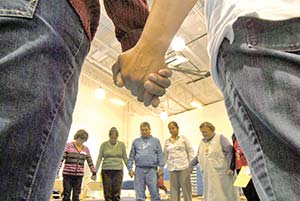Educators learn the warning signs of social ills
By Erny Zah
Navajo Times
SEBA DALKAI, Ariz., Feb. 11, 2010

(Special to the Times - Donovan Quintero)
Counselors, school officials and other mental health practitioners join hands in prayer before concluding their day of training Feb. 4 at the Seba Dalkai Boarding School in Seba Dalkai, Ariz.
A group of 19 facilitators sat in a circle to debrief each other about their work with teenagers regarding suicide prevention and awareness.
They read handwritten notes from the children about what was bothering them that day.
While some responses dealt with family trauma involving domestic violence, alcoholism and other social issues, one response read: "Nothing bothers me anymore. The past is the past. I don't want to talk about it."
"Suicide is a topic that isn't well-known, that isn't talked about," said Kathleen Atene, a public health nurse, during the work session last week.
Atene was one of nearly 50 participants in a weeklong training session on suicide prevention and awareness called Native H.O.P.E. (Helping Our People Endure). Nearly 40 Seba Dalkai students participated for three days, while facilitators from the school and other agencies were there a full week to learn how to be peer counselors.
One thing's for certain, there's a need for it here. According to an Indian Health Service report using statistics from 2000 through 2002, suicide rates in the Navajo Nation are nearly double that of the United States as a whole.
Dr. Peter Stuart, chief psychologist for the IHS's Navajo Area, said newer data isn't completely accurate but the trends for suicide rates are consistent with that of the 2002 study.
He said the Navajos most at risk are teenage boys and men, and that suicide is not always preceded by depression.
"It seems to be for many (Navajo) people, suicidal thinking develops more rapidly and suicidal actions are more impulsive ... if the victim's out of employment or ending a relationship," he said, adding that other life factors play into it as well.
At the training, students and facilitators - a mix of professionals from several different agencies - learned the signs of depression.
"(The training) kind of helped me realize my stress and helped me to help my friends," said Shawn Yesslith, 14, who attends eighth grade at Seba Dalkai.
He added that he knows some classmates who have had suicidal thoughts and that this training will help him help them.
Since Seba Dalkai has students who board there during the week as well as day students, Principal Mike Grug said school officials must be extra vigilant in watching for signs of a troubled child, so he welcomes any awareness his staff and students can gain.
"We don't ever want to wait until it's too late," he said, adding that he knows of other boarding schools that had a student who committed suicide in the dorm.
But when it come to practicing some of the tools, like recognizing behaviors and establishing trust with the children, H.O.P.E. developer Clayton Small said that he has the facilitators committed to an action plan that includes developing support groups and hosting depression and suicide awareness activities.
But one community member says that the work to create more awareness is going to continue well after the training is over.
"It's going to take a lot more than this week and an action plan. It's going to be a challenge," said Mary Freddie, education technician at Seba Dalkai School. "It's going to be about empowering the community."
Among the speakers was Miss Navajo Nation Tashina Nelson, who has made awareness and prevention of depression and suicide a main part of her year's mission.

